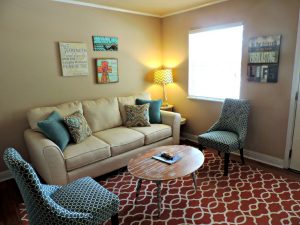Creating an Inviting Nursing Home

The interior design and features of a nursing home are very important and can affect the well-being of residents. It is about choosing the appropriate lighting, colours, fixtures, and furniture to emulate a homely environment which is safe and comfortable.
Colour:
Colour affects people emotionally and physically. It may promote social interaction, promote eating and help individuals find their way around. It contributes hugely to an intriguing and inspirational atmosphere. Many dementia-friendly colour schemes are possible. They ought to reflect people’s spiritual and religious needs and ethnic and professional backgrounds. Where there could be personalisation, colour should reflect personal preferences.
Ageing leads to diminished vision, mainly because of changes in the eye, and individuals with dementia frequently have vision issues including diminished depth perception, spatial disorientation, altered colour perception and decreased capacity to comprehend contrasts.
Like many elderly people, individuals with dementia might
have cataracts, macular degeneration, diabetes retinopathy, color-blindness and glaucoma. Blurred eyesight and reduction of peripheral and central vision would be the most serious consequences of these impairments. Some residents may have custom instruments to enhance their quality of life however some are severely impaired. Therefore, colour plays a huge role in providing comfort and happiness to the elderly. Always consider softened and familiar colours when designing your nursing home.

Lighting:
Lighting helps powerful colour comparison. The sum of natural daylight ought to impact the selection of colours as colour is clearly altered by various light sources. Carpet, wall colour, fabrics, accessories, and furniture seem much brighter in direct daylight compared to under artificial lighting. Examine your colour options daily and daylight where they should be utilized. Adequate light assists with fall prevention.
Effects of reduced natural sunlight levels comprise:
- Worsened sundowning
- Weak wayfinding
- Lower degrees of ability to perform daily tasks, mainly for individuals severely cognitively impaired
- Disrupted circadian rhythm
- Bad vitamin D synthesis
- Poor calcium intake
Natural lighting can enhance physical health and should be a key characteristic in designing buildings that are heal
thy. The ideal lighting system brings natural light indoors.
Architects and designers have strategies to disperse light. They may:
- Utilize many resources of daylight from a variety of directions
- Hide daylight sources from sight
- Utilize taller ceilings and greater window openings to allow light move farther into buildings
- Utilize skylights, clerestories and light shelves to decrease glare
Having more natural lighting can decrease energy costs; however, glare and inconsistency of light can be an issue. Significant factors for a high grade of light include:
- Glare control
- Flicker-free light
- Uniform basic lighting
- Directing light sources to visual activity areas
Fixtures and fittings:
Fixtures and fittings like grab rails, showers and bathrooms give precious pathways and informative clues to individuals with dementia. When picking fittings concentrate on what’s comfortable and simple to use. What’s recognizable to a single person might not have to the following: intimacy relates to an individual’s life history and to the cultural and sociological background.
Pick fittings and fixtures that:
- Appear recognisable
- Belong to a national setting
- Are comfy to utilise
- Are secure
- Are colour-contrasted
- Suit individuals with reduced guide agility
Fixtures and fittings are sometimes utilised for casual Functions. A towel rail may turn into a catch rail in a crisis and needs to be pow
erful enough to take the burden of the man with it.
Handles:
Handles are less difficult than doorknobs to utilise. When picking handles for doors, cabinets and wardrobes remember C-shaped handles are easier to grasp, largely for those who have reduced agility. Fixing handles at a 45-degree angle into the ground is most appropriate for individuals with seriously diminished agility.
Furniture and Furnishings:
Furniture and furnishings are possibly what makes an environment feel like home. They ought to be colour contrasted for simple visibility. Furniture must have rounded edges to aid injury prevention and must reflect home-like spaces and individual tastes. Some folks might need specially designed beds, a traditional bed head generates a more home-like atmosphere. Residents ought to be able to sit down on the edge of their mattress. The conventional seat height of a mattress is 600mm. Always purchase top-quality mattresses.
They need to:
- Be supportive and firm
- Reflect older people’s wants
- Be flame resistant
- Possess a watertight cover
Floor coverings:
Flooring materials are often grouped as resilient (sheet vinyl, vinyl plastic, and plastic tile), hard surface and carpet. When picking finishes, consider their long-term advantages and the effect of tough surfaces. Carpet and resilient flooring seem better, are more silent, and therefore are somewhat more home-like. Ensure floors accommodate for any medical instruments such as wheelchairs to be easily used.
Cushions and Cabinets:
Fabric drapes can create a cosy atmosphere and help decrease sound. Use curtains which could be pulled around by hand instead of drapes using cords and pulleys or venetian blinds that are fiddly to operate. Cushions can make a home-like sense of living and individual bedrooms and are a simple way for individuals to re-create their own spaces. They are a good opportunity to add a splash of colour.
